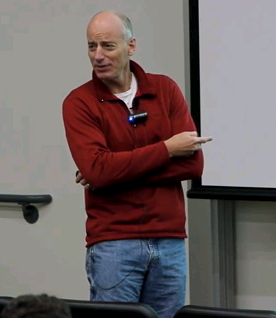UCI Chem 131C Thermodynamics and Chemical Dynamics (Spring 2012)
Lec 13. Thermodynamics and Chemical Dynamics -- The Carnot Cycle --
View the complete course: ../courses/chem_131c_thermodynamics_and_chemical_dynamics.html
Instructor: Reginald Penner, Ph.D.
License: Creative Commons BY-NC-SA
Terms of Use: ../info.
More courses at http://ocw.uci.edu
Description: In Chemistry 131C, students will study how to calculate macroscopic chemical properties of systems. This course will build on the microscopic understanding (Chemical Physics) to reinforce and expand your understanding of the basic thermo-chemistry concepts from General Chemistry (Physical Chemistry.) We then go on to study how chemical reaction rates are measured and calculated from molecular properties. Topics covered include: Energy, entropy, and the thermodynamic potentials; Chemical equilibrium; and Chemical kinetics.
Thermodynamics and Chemical Dynamics (Chem 131C) is part of OpenChem: ../openchem/
Recorded on May 2, 2012.
Index of Topics:
00:06 - Introduction: The Carnot Cycle (Lecture 13)
01:02 - Announcements
02:39 - Midterm I Score
07:04 - How Am I Doing (Scores)?
09:37 - Sadi Carnot
10:52 - A heat engine extracts work from a temperature gradient.
11:38 - The Carnot Cycle
12:43 - The Carnot Cycle (Graph)
12:56 - ...ANY process can be decomposed into a large number of Carnot Cycles, so...
14:59 - how efficient is a heat engine?
16:12 - Let's prove this:
16:37 - (Graph) now, this pair of (T,V) data points lie on an adiabat:
20:27 - Problem: What is the entropy change...
21:05 - Since S is a state function, we can write:
24:07 - Formulas: What do we know?
25:55 - so (once again) represented in a Temperature-Entropy...
26:43 - What if one or more steps of the process are irreversible?
30:13 - Rudolf Clausius!
30:50 - T-shirt of Clausius
31:31 - and a more general statement of this is called the Clausius Inequality
31:59 - let's say we transition from state I to state 2...
33:02 - according to the Clausius inequality:
33:42 -The Second Law of Thermodynamics.
33:48 - This equation makes predictions about 3 types of processes:
34:30 - If we consider, in particular, an isolated system...
35:18 - some simple but important examples:
36:55 - some simple but important examples: (II)
39:53- Because S, like U, is a state function, you can add...
40:34 - example - Calculate the entropy change when Ar gas...
Required attribution: Penner, Reginald Thermodynamics and Chemical Dynamics 131C (UCI OpenCourseWare: University of California, Irvine), ../courses/chem_131c_thermodynamics_and_chemical_dynamics.html. [Access date]. License: Creative Commons Attribution-ShareAlike 3.0 United States License.


